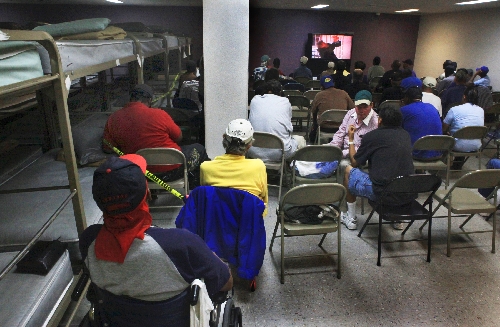Stayin’ cool: How the Las Vegas Valley homeless keep out of the heat



Broken shopping carts packed full of odds and ends litter highway underpasses valleywide.
Their homeless owners are desperately seeking shade from the sun’s harsh rays. Some lay blankets and tarps across two or more carts, creating a makeshift shelter in an attempt to stay cool while triple-digit temperatures broil the area.
“There is no other option than to get out of the heat,” said Charlie Desiderio, director of development and marketing for the Salvation Army Clark County Administration. “You have to get into someplace air-conditioned. You have to drink water and do anything you can do to keep your body temperature down.”
According to the county’s homeless census conducted in January, there are 3,608 unsheltered homeless people — an increase of 19.2 percent or 581 more people than in 2009. These are people who live on the streets, in vehicles or other makeshift shelters “not meant for human habitation.” They live in encampments throughout the valley.
The total number of homeless in Southern Nevada has decreased 15 percent since 2009 — about 2,000 fewer overall — from 13,338 when the census was conducted two years ago to 11,269.
Some won’t get the relief from the heat they need. Most will head to local cooling stations and day shelters.
Leslie Carmine, director of communications for Catholic Charities, said the Summer Day Shelter program, open 9 a.m. to 5 p.m. daily May through September, can hold about 100 people at a time but usually holds up to 250 people daily. An overflow area is available when the crowds swell.
Along with a meal and a place to get cleaned up, people can find shelter from the heat, water to drink and showers to help cool them down.
“People come here and know it is a safe place,” Carmine said. “They can rest their minds and not worry about who is around.”
David Cobo watches television inside an air-conditioned room at Catholic Charities’ St. Vincent campus, 1501 Las Vegas Blvd. North.
This is the only place open to the homeless year round.
Cobo’s weathered hands tell the story of a hard-working man who laid tile for decades until a motorcycle accident five years ago left him handicapped and unable to earn a living.
The 54-year-old has been homeless since the accident. Cobo is diabetic and losing his right leg to the disease. He walks with a cane and a walker.
His suntanned skin comes from the few hours a day he has to spend outdoors when Catholic Charities closes its day shelter to open the night shelter.
“I go looking for something to eat, trying to stay out of the sun as much as possible,” Cobo said. “Soon, it will be 110 or 115 (degrees outside). Life in the summer is very difficult. Because of my handicap, I can’t walk long distances, especially when it’s hotter.”
Douglas Clary, 62, said he tries “to find a little shade tree here or there.”
Otherwise, he hits a cooling station before heading to Catholic Charities for some food and a bed each day.
Clary has been homeless for 1½ years after suffering a stroke. He lost both of his jobs while recovering at University Medical Center, 1800 W. Charleston Blvd.
“It’s no fun,” Clary said. “Usually, what I try to do is adjust my mind, know that the heat is here, it’s gonna be here, and after a certain temperature, I have to find some place to go. The city has these cooling stations. It’s some relief. It’s some place to go.”
Carmine said many of the nonprofit’s clients have disabilities.
“It is especially hard for them to stand out in the heat,” Carmine said.
At the Las Vegas Rescue Mission, 480 W. Bonanza Road, less than two miles from Catholic Charities, water dispensers are stationed at the complex’s gates. Olin Jones, assistant operations manager, said it’s the only relief the mission can truly offer during the summer.
“If we could, we would,” Jones said. “The problem is, we have other programs during the day, and we receive no government funding whatsoever. There’s no security for people who live on property during the day.”
Other agencies offering relief include the Salvation Army.
“The heat (in Las Vegas) is a disaster,” Desiderio said. “It is about to be 115 degrees. Some men and women don’t have the mental facilities to say, ‘I gotta get in out of the heat.’ The heat makes their bodies tired and weak. We are constantly making sure they are hydrated.”
Desiderio said people need to keep their bodies cool inside and out.
“We are constantly encouraging them to drink,” Desiderio said.
Another relief option Desiderio said can be vital are the showers, which are open 8 a.m. to 4 p.m. seven days a week at Salvation Army locations.
“It is good to shower because it cools the whole body down,” Desiderio said. “It doesn’t even have to be a cold shower.”
On the outskirts of North Las Vegas at the Salvation Army, 35 W. Owens Ave., a cooling station with plenty of water provides relief to an average of 125 to 250 people daily, said Michael Olson, director of the 5-acre Owens Avenue campus.
About 420 clients sleep on the property every night.
“It’s more than a retreat from heat,” Olson said. “It’s about hydration. We can survive out of direct sun, but you need to be hydrated. It’s a basic problem day-to-day. We find people with heat stroke and heat exhaustion.”
Clients drink cool city water, but there are about 20 pallets of bottled water on hand, he added. Even at the Henderson Salvation Army, 830 E. Lake Mead Parkway, people make their way out of the heat into the air-conditioned building.
” They come in at the hottest part of the day and stay in the building,” said William Cobb , who oversees the Henderson campus. “We hand out water and sack lunches.”
Cobb said most homeless people have learned how to survive the Las Vegas summer.
“They pretty much know the ropes,” Cobb said. “It is rare to get a person who doesn’t know how to manage the heat.”
Near Tropicana Avenue and Maryland Parkway, Tim Mullin, executive director for the Nevada Partnership for Homeless Youth, sees a different demographic of homelessness.
Like other organizations, Mullin and his staff pass out water, offer showers and provide a place to escape the heat. However, the organization caters specifically to teenagers up to 18 years old, with the average age about 16.
“These kids have no one else to turn to,” Mullin said.
Out on the streets, Mullin hands out hygiene products and water to youths around low-income areas trying to establish a relationship and build trust.
When children come into the center, they also meet with a case manager who sees how to offer more help.
Carmine added that individuals and groups often go to the encampments and hand out water to help provide relief.
“We don’t recommend that,” Carmine said. “If you want to hand out water, contact the shelter. The shelter is a safe environment to hand things out.”
Contact Downtown and North Las Vegas View reporter Kristi Jourdan at kjourdan@viewnews.com or 383-0492 or Henderson and Anthem View reporter Michael Lyle at mlyle@viewnews.com or 387-5201.
To helpCatholic Charities and the Salvation Army serve as the county’s summer day shelters and are open seven days a week throughout the summer.
Catholic Charities, 1501 Las Vegas Blvd. North, is open 9 a.m. to 5 p.m. Salvation Army, 31 W. Owens Ave., is open from 11 a.m. to 7 p.m.
To find out more about cooling station locations throughout the county, dial 2-1-1 from any pay phone or visit helphopehome.org.












